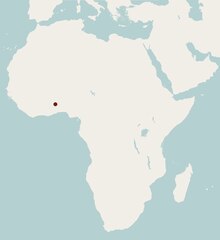| Togo mouse | |
|---|---|
| Scientific classification | |
| Domain: | Eukaryota |
| Kingdom: | Animalia |
| Phylum: | Chordata |
| Class: | Mammalia |
| Order: | Rodentia |
| Family: | Muridae |
| Subfamily: | Leimacomyinae Musser & Carleton, 2005 |
| Genus: | Leimacomys Matschie, 1893 |
| Species: | L. buettneri
|
| Binomial name | |
| Leimacomys buettneri Matschie, 1893
| |

| |
The Togo mouse (Leimacomys buettneri), also known as Büttner's African forest mouse or the groove-toothed forest mouse, is a unique muroid rodent known from only two specimens taken from near the type locality of Bismarckburg, near Yege, Togo, in 1890. Its genus is monotypic.
Description and natural history
The entirety of known material for this species consists of a single, poor-quality dry skin, a fluid-preserved animal, and a cranium and mandible. The cranium and mandible are from different animals. The material is deposited in the Zoologisches Museum of Humboldt University in Berlin, Germany.
The head and body length is 118 mm (4.6 in) with a tail of 37 mm (1.5 in). This tail is unusually short relative to the body length (ratio of 37%) and is considered an important diagnostic feature. The animal is dark to grey brown above and pale grey brown below. Ears are small and hairy. Feet are also somewhat hairy. The tail may be naked or slightly haired.
The incisors are shallowly grooved. The snout is long and wide, the interorbital width is broad, and the zygomatic plate is large).[2]
Based on skull morphology, the Togo mouse is presumed to be insectivorous.[3] Very little is known about the habits of this unusual mouse.
Classification
Leimacomys has been transferred back and forth between the Dendromurinae and the Murinae since its discovery. It most closely resembles Lophuromys, which has been transferred to a newly erected Deomyinae on the basis of molecular data. The association with Lophuromys is thought to be due to convergent evolution due to similar diets.[4] Tooth characters resemble dendromurines, Mystromys or basal gerbils. Denys et al.[5] generated a phylogeny that suggested, with limited support, Leimacomys is a sister taxon to the Gerbillinae.
Musser and Carleton[6] chose to erect a new subfamily, Leimacomyinae, to house this species. They placed it in the family Muridae due to its potential connection to either the Gerbillinae or Deomyinae, but emphasized that a broad phylogenetic study including Leimacomys, and a host of nesomyids and murids, is needed to determine its appropriate position.
Conservation status
The Togo mouse is considered to be either critically endangered or extinct depending on the authority. Schlitter[7] classified it as extinct, because subsequent surveys to the area failed to recover it. Grubb et al. (1998)[citation needed] noted these surveys inadequately sampled appropriate habitat in Togo and neighboring Ghana, and they were reluctant to declare the species extinct. Musser and Carleton[8] also emphasized the insectivorous muroids as a group have proven difficult to capture, and intense surveys of high-elevation forests in this region are required to determine if it still persists.
The IUCN[1] currently describes the Togo mouse as "data deficient". This species has also been recently added on Re:wild’s 25 most wanted lost species[9]
References
- ^ a b Van der Straeten & Schlitter (2016). "Leimacomys buettneri". IUCN Red List of Threatened Species. 2016. Retrieved 22 June 2021.
- ^ Musser, G. G. and M. D. Carleton. 2005. Superfamily Muroidea. Pp. 894-1531 in Mammal Species of the World a Taxonomic and Geographic Reference. D. E. Wilson and D. M. Reeder eds. Johns Hopkins University Press, Baltimore.
- ^ Dieterlen, F. 1976. Bemerkungen über Leimacomys büttneri Matschie, 1893 (Dendromurinae), Cricetidae, Rodentia). Säugetierkunde, 39:229-231.
- ^ Dieterlen, F. 1976. Bemerkungen über Leimacomys büttneri Matschie, 1893 (Dendromurinae), Cricetidae, Rodentia). Säugetierkunde, 39:229-231.
- ^ Denys, C., J. Michaux, F. Catzeflis, S. Ducrocq, and P. Chevret. 1995. Morphological and molecular data against the monophyly of Dendromurinae (Muridae: Rodentia). Bonner Zoologische Beiträge, 45:173-190.
- ^ Musser, G. G. and M. D. Carleton. 2005. Superfamily Muroidea. Pp. 894-1531 in Mammal Species of the World a Taxonomic and Geographic Reference. D. E. Wilson and D. M. Reeder eds. Johns Hopkins University Press, Baltimore.
- ^ Schlitter, D. A. 1989. African rodents of special concern. Pp. 33-39 in Rodents: a world survey of species of conservation concern. W. Z. Lidicker Jr. ed. Occasional Papers IUCN Species Survival Commission no. 4.
- ^ Musser, G. G. and M. D. Carleton. 2005. Superfamily Muroidea. Pp. 894-1531 in Mammal Species of the World a Taxonomic and Geographic Reference. D. E. Wilson and D. M. Reeder eds. Johns Hopkins University Press, Baltimore.
- ^ "Re:wild's Search for Lost Species". www.rewild.org. Retrieved 2023-11-26.
Further reading
- Grubb et al. 1998.
- Musser, G. G. and M. D. Carleton. 1993. Family Muridae. pp. 501–755 in Mammal Species of the World a Taxonomic and Geographic Reference. D. E. Wilson and D. M. Reeder eds. Smithsonian Institution Press, Washington D.C.
- Nowak, Ronald M. 1999. Walker's Mammals of the World, 6th edition. Johns Hopkins University Press, 1936 pp. ISBN 978-0-8018-5789-8

